“Cheerfully share your home with those who need a meal or a place to stay.”
1 Peter 4:9 (NLT)
“There is only one boss. The Guest. And he can fire everybody in the company from the chairman on down, simply by spending his money somewhere else.”
Mr Moriarty (CEO of Hotel Casanova Venezia)
Discover the purpose of your work and your corporation
What is your purpose in work?
- You find fulfillment in crafting delightful experiences for people.
- The pursuit of realizing a dream project brings you immense joy.
What drives your corporation’s core value?
- Build and expand a prominent brand identity in the burgeoning market.
- Capture the new opportunity to enrich your esteemed portfolio.
Target market population (million) and flight time–Tourism hotel
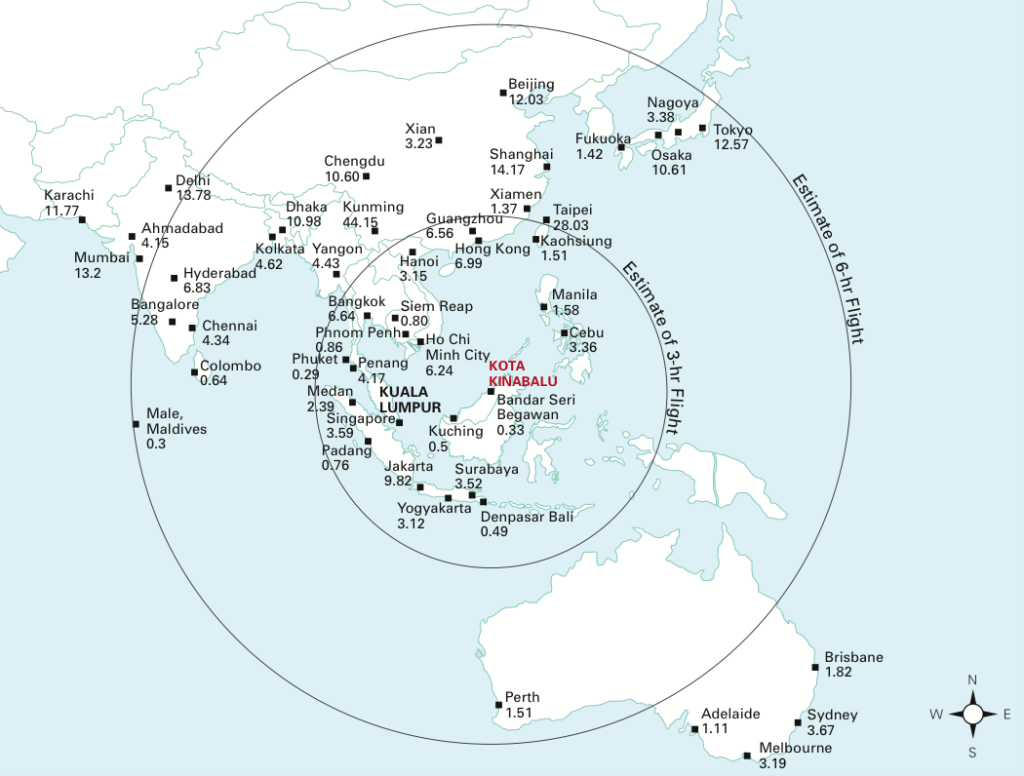
1.0 Executive Summary
Mission
- Purpose: Forge strategic partnerships with key customers, government tourism agencies, investors, and renowned international 5-star hotel groups.
- Phase 1: Develop and manage a portfolio of 20 luxury 5-star hotels, each boasting 500 rooms, on the enchanting Borneo Island.
Key Management Team
- Mentors: Visionary pioneers and industry leaders, offering invaluable guidance and inspiration through a vast global network.
- Coaches: Mission-oriented industry experts providing practical solutions, ensuring a focused pursuit of objectives.
- Partners:
- A project leadership group with a proven track record in developing, operating, and managing financial aspects of the tourism hotel industry.
- A reputable investment manager with access to diverse funding sources in the tourism hotel sector.
- International tourism hotel operators.
- Reputable local tourism hotel operators with procurement capabilities, a robust local network, sound financial status, and government support.
- Target market customer groups.
Product Benefits
- Team: Collaborate with target market customers, tourism transportation groups, destination operators, hotel developers, and financial investors.
- Integrate: Seamless integration with international hotel groups and local developers ensuring excellence in business marketing, management, finance, and operations.
- Model: Proven success model anchored in secured customers and sustainable income.
Target Market
- Customers: Focus on key customers, including major MNCs and State-Owned Enterprises in Asia, with a workforce of 98 million employees in North Asia, India, and the Middle East.
Financial Projections
- Investment: Initial investment of US$4 billion.
- Cost: Operational cost estimated at US$604.5 million/year.
- Revenue: Projected annual revenue of US$930 million.
- Income: Expected annual income of US$325.5 million.
- Payback: Anticipated payback period of 12.15 years.

Unique Business Model
- Team: Enlist a top-tier international management team with a track record of success.
- Choice: Offer an array of 20 distinctive 5-star hotels under a single entity, providing extensive options for target tourists.
- Service: Implement a differentiation strategy delivering high-quality services through a holistic approach tailored to the target tourist.
- Location: Identify and seize prime locations as early movers in the market.
- Brand: Establish a regional chain focusing on the exclusive 5-star hotel brand image of Borneo.
- Market: Form strategic alliances with target market segments in the planning stage to secure anchor tourists, ensuring a steady and substantial income stream.
2.0 Mission
2.1 Problem
- Vision: Borneo lacks a cohesive vision for the holistic development of its tourism industry across the entire island.
- Exposure: The tourism landscape in Borneo remains largely unexplored, with limited international exposure.
- Lack: Borneo faces challenges in establishing an efficient tourism infrastructure and attracting sophisticated foreign investment to the industry.
2.2 Solution
- Unity: Propose a practical and unified strategy involving collaboration among the governments of Brunei, Malaysia (Sabah and Sarawak), and Indonesia (five Kalimantan provinces), alongside industry stakeholders, to drive the development of tourism in Borneo.
- Support: Advocate for governments to offer financial and policy incentives aimed at attracting foreign investment to enhance tourism infrastructure.
2.3 Mission Revitalized
- Goal: Establish a strategic alliance with international hotel operators, financial investors, local hotel developers, and government agencies to collaboratively plan, finance, develop, and operate 20 luxury 5-star hotels, each with 500 rooms, across Borneo Island.
- Stage 1: A targeted timeline of seven years to achieve this ambitious vision.


Sources: 1. SEDIA 2007 / 2. Wikipedia. Flanegan 2008 / 3. Wikimedia 2006 / 4. Wikipedia Barnett / 5. Wikipedia. Grant 1847 / 6. Wikipedia. Mike86, 2007 / 7. Wikipedia. Pierre, 2013 / 8. cruising.me / 9. Wikipedia. Kurniawan Dwi, 2013 / 10. Wikipedia. Consigliere Ivan 2018 / 11. Source: Urban Plus. 2022 / 12. kerajaan-indonesia.blogspot 2010 photo: Max Alkadrie.
3.0 Product
3.1 Elevating Luxury
- 5-star Luxury Hotel Criteria
- Theme of Opulence
- Comprehensive Facilities
- Personalized Services
- Outstanding Design
- Exceeding Expectations
- Ideal Locations
- City-Centric Sites
- Integration with New Shopping Malls, Food Courts, and Large Commercial Developments
- Accessibility to Tourism Hotspots
3.2 Distinctive Product Attributes
- For Tourists
- Unique Experience: Immerse in tropical garden settings, distinctive tropical design, and captivating tropical aromas.
- Proximity: Convenient access to specialized shopping, culinary delights, and key tourism attractions.
- Pampering: A quintessential attribute ensuring guests have a uniquely delightful experience, fostering repeat customers.
- For Investors
- Uniqueness: The dynamic nature of 5-star hotel investment development, execution, and operation.
- Patience: Acknowledging the need for patience and deep pockets due to the high capital investment and long-term payback period.
- Barrier: The high entry barrier offers a steady income from loyal customers and promises long-term growth on the investment.
3.3 Compelling Product Benefits
- Team: Collaborate with target market customers, tourism transportation groups, destination operators, hotel developers, and financial investors.
- Integration: Seamlessly integrate with international hotel groups and local developers for excellence in business marketing, management, finance, and operations.
- Proven Model: A successful model anchored in secured customers and reliable income.
3.4 Competitive Product Advantages
- Marketing Mastery: Strategic alliance with an international hotel group lends a competitive edge with an established brand name, anticipated high service standards, and a pool of loyal customers.
- Financial Confidence: The international hotel group instills confidence with financial institutions well-versed in the hotel industry.
- Competitive Edge: International luxury hotel operators gain a cost advantage through global scale, while local developers contribute differentiation through site selection and local insights.
- Ideal Location: Borneo’s proximity, just 3-6 hours’ flight from Asia Pacific cities, further enhances its appeal.
4.0 Market
4.1 Market Segment
- Types: The luxury hotel landscape in Borneo encompasses resort hotels and city hotels.
- Eco: Resort hotels cater to eco-tourists seeking a harmonious connection with nature. Experiential: City hotels cater to experience tourism visitors, emphasizing convenience and local culture.
- Events: Stage 2 of event tourism includes medical tourism, theme park holidays, sports events, government meetings, conference travellers, and other scheduled activities, offering a blend of experiences.
4.2 Target Market Strategy
- Location: Capitalize on the proximity of Borneo’s many destination attraction sites near the city, developing them into expansive tourism complexes.
- Early Advantage: Early movers gain a strategic edge by selecting optimal sites.
- Strategic Focus: Target market strategy centres on ideal locations, superior products, and exceptional services.
- Differentiation: Stand out through differentiation based on value and quality services.
4.3 Market Needs
- Borneo: In 2018, Borneo welcomed 6 million international travellers, as reported by CAPA.
- Sabah: 2019 recorded 4.4 million visitors, with an ambitious projection of 13 million by 2050. Sarawak: 2019 saw 4.6 million visitors, targeting 14 million by 2050.
- Brunei: In 2018, Brunei hosted 0.3 million visitors, with a vision of reaching 5 million by 2050. Kalimantan: The new capital anticipates a population of 3 million, aiming for 6 million visitors by 2050.
- Growth: Borneo aims to attract 30 million tourists by 2050, surpassing 2019 figures of Hong Kong (29 million) and Bangkok (24 million).
4.4 Driving Growth
- Unique Offerings: Borneo’s allure lies in pristine seas, diving opportunities, coral reefs, culinary diversity, proximity, competitive budgets, a relaxed atmosphere, shopping, rainforest tours, wildlife, and tropical settings.
- Asia’s Rising Middle Class: The growing middle class in China, India, Southeast Asia, and Indochina is poised to be a significant driver of growth.
- Western Appeal: Australian, American, and European tourists are expected to flock to Borneo once infrastructure and tourist destinations are fully developed.
4.5 Key Customers
Target: Key customers include the largest MNCs and State-Owned Enterprises in Asia, boasting a workforce of 98 million employees in North Asia, India, and the Middle East.
4.6 Industry and Competition
- Key Players: Luxury hotel groups dominate the current market, such as Hilton, Hyatt, Marriott, and Shangri-La.
- Sabah Snapshot: In Kota Kinabalu, 2018 saw 10,000 rooms with a 74.6% occupancy rate among 3 to 5-star hotels.
- Sarawak’s Presence: Notable hotels include Hilton Kuching, Pullman Kuching, and Mulu Marriott Resort.
- Kalimantan Scene: Astara Hotel, Aston Samarinda, and Swiss-Belhotel are prominent players in Kalimantan.
- Brunei Elite: Empire Brunei, Radisson Hotel, and Rizqun International Hotel are key players in Brunei.
- Global Giants: Internationally, major luxury 5-star hotel groups include Accor, Four Seasons, Hyatt, InterContinental, Marriott, and Wyndham.
5.0 Operation
5.1 Operation–hotel development stages

5.2 Operation–organisation chart example
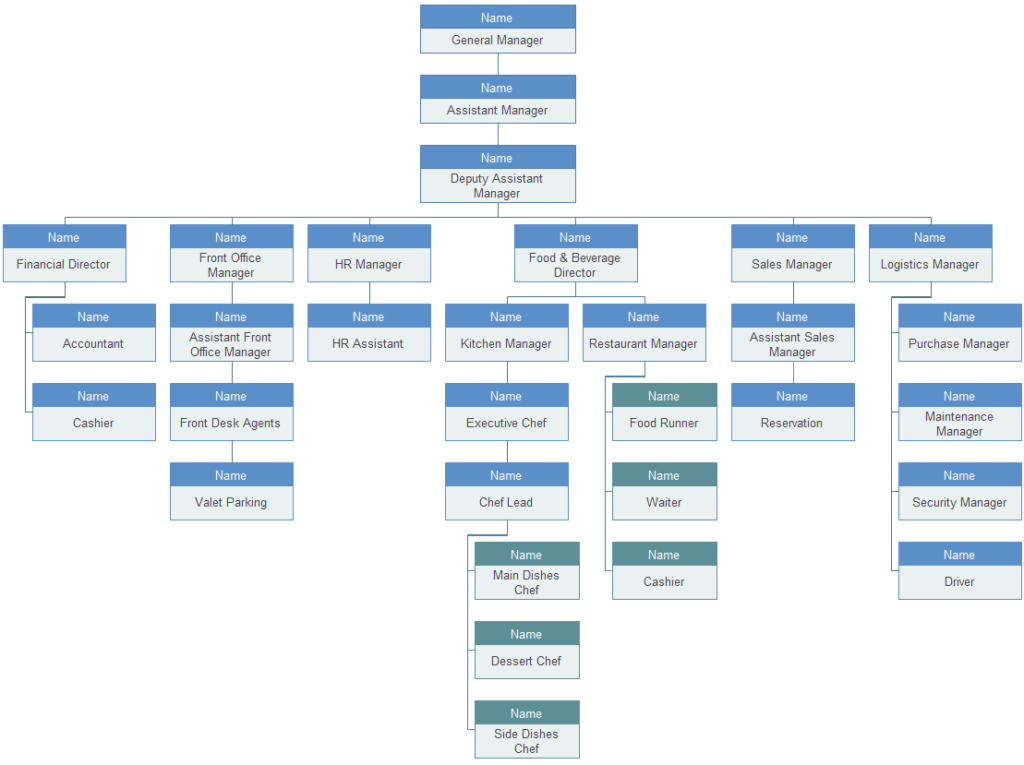
5.3 Operation–hotel ground floor plan
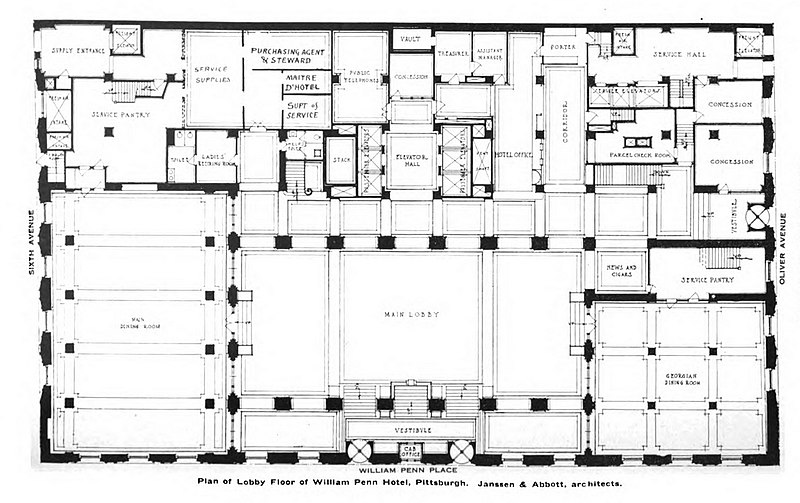
5.4 Operation–management models comparison

5.5 Operation–top hotel group management profile

6.0 Financial Implications
6.1 Investment Segment
5-star Hotel Investment
- US$400,000/room x 500 rooms x 20 hotels = US$4 billion
Case study 1: Malaysia
- 5-star hotel: US$90 million–US$425 million.
- 5-star hotel: US$106 million / 150 rooms / 23 floors / Kuala Lumpur
- 4-star hotel: US$120 million / 482 rooms / 30 floors / Kuala Lumpur
- 3-star hotel: US$8 million / 106 rooms / 10 floors / Tawau
Case Study 1: Malaysia
- 5-star hotel range: US$90 million–US$425 million
- Example: US$106 million for a 150-room, 23-floor hotel in Kuala Lumpur
- 4-star hotel: US$120 million for a 482-room, 30-floor hotel in Kuala Lumpur
- 3-star hotel: US$8 million for a 106-room, 10-floor hotel in Tawau
Case Study 2: Asia Hotel Room Value
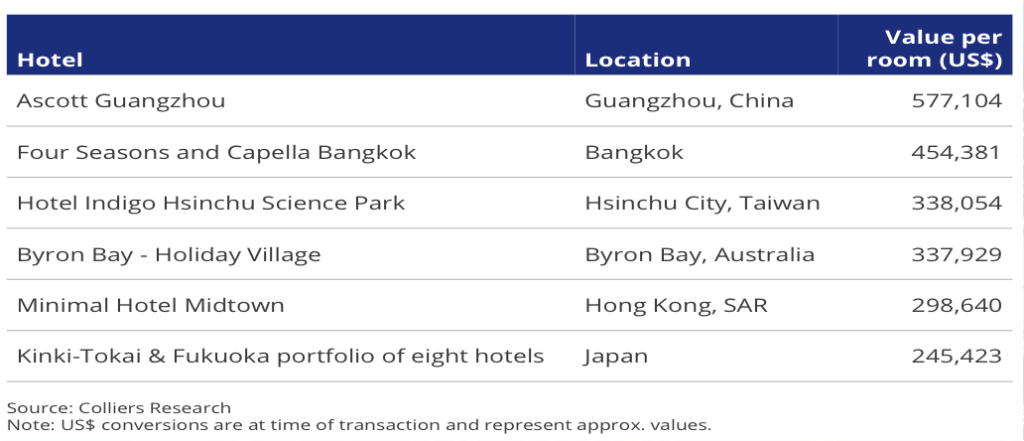
Case Study 3: Asia Pacific Hotel Price

Case Study 4: Construction Cost for a 5-star Luxury Hotel (2019)
- Malaysia and Indonesia: US$2,000–2,500/m2
- Hong Kong: US$4,000–$5,500/m2
- USA: US$600,000/room
Case Study 5: Hotel Development Cost Breakdown
- Land: 10–15%
- Construction: 55–66%
- Administration Fee: 10–12%
- Furnishing: 9–10%
- Commissioning Fee: 3–5%
Case Study 6: Australia 2018
City Rooms Sales Price (US$)
Darwin 152 $144m
Brisbane 102 $28m
Perth 368 $154m
Case study 7: Australia Development Cost
City Rooms Development cost (US$)
Sydney 240 $230m
Darwin 240 $153m
Tasmania 176 $307m
Case Study 8: Cruise Ship Investment Cost
New cruise ship Pre-owned cruise ship


Source: The Muster Station. Camosse, 2017 Source: QPS Marine Ships. Caine, 2021
6.2 Production Cost
- Room:
- $300 X 65% X 65% = US$126.75/room/night
- Food:
- $300 X 30% X 65% = US$58.50/room/night
- Functions:
- $300 X 5% X 65% = US$9.75/room/night
- Subtotal:
- US$195/room/night
- Total:
- 10,000 rooms X US$195 X 310 days = US$604.5 million/year
Case Study 1: Franchise and Management Fee
- Franchise Fee: Approximately US$500 per room.
- Ongoing Management Fee: Around 5% of the top-line revenue.
Case Study 2: Operation Cost
- Departmental Expenses: Range between 37–44%.
- Labour Cost: Between 33–36% of total revenue.
Case Study 3: Room Operation Cost Breakdown Example
- Rooms Payroll: 19%
- Rooms Expenses: 15%
- Overhead Payroll: 10%
- Overhead Expenses: 13–15%
- Energy Costs: 5–6%
- Owner Expenses: 28%
- Cash Flow: 8%
Case Study 4: Management Fee Example
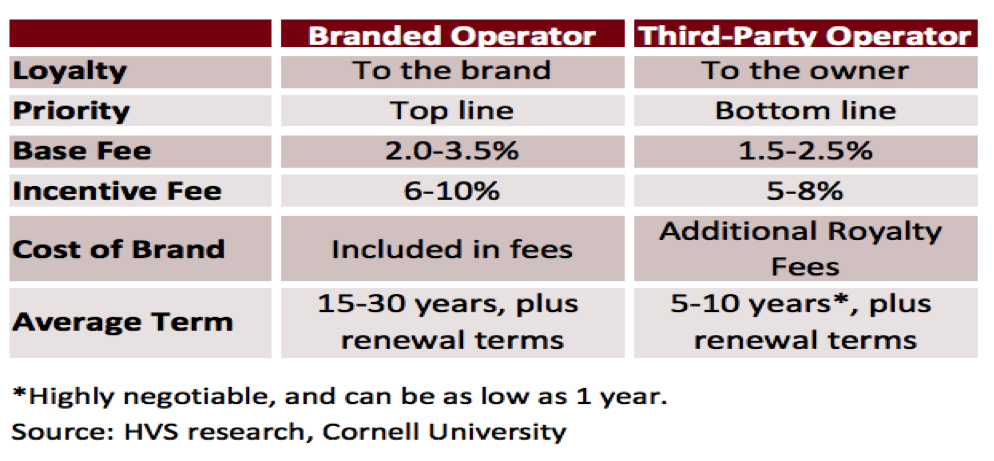
6.3 Prices and Revenue
- Room:
- $300 X 65% = US$195/room/night
- Food:
- $300 X 30% = US$90/room/night
- Functions:
- $300 X 5% = US$15/room/night
- Subtotal:
- US$300/room/night
- Total:
- 10,000 rooms X US$300 X 310 days = US$930 million/year
Case Study 1: Three Major Income Streams for 5-star Hotel
- Room Sales: 53–65%
- Food/Beverage: 30–33%
- Rental: 4–10% (Includes income from exhibitions, conventions, business function room facilities, commercial rentals, and car parking.)
Case Study 2: Room Rates for a 5-star Hotel
- Asian Cities: US$110–US$875/night
- Bali: $180/night
- Kota Kinabalu: US$120–US$180 per night
5-star hotel cost

6.4 Financial Returns

Case Study 1: 2018 Study of 5-star Hotels
- Gross Operating Profit: 32–38.5%
- Room Revenue: 59% of the income
- F & B: 32%
- ROI: 10–12%
- Payback Period: 7–15 years
- Annual cash flow can lead to higher profitability after the payback period.
- Substantial return on investment can be achieved when the hotel is sold after the payback period.
2019 International Group
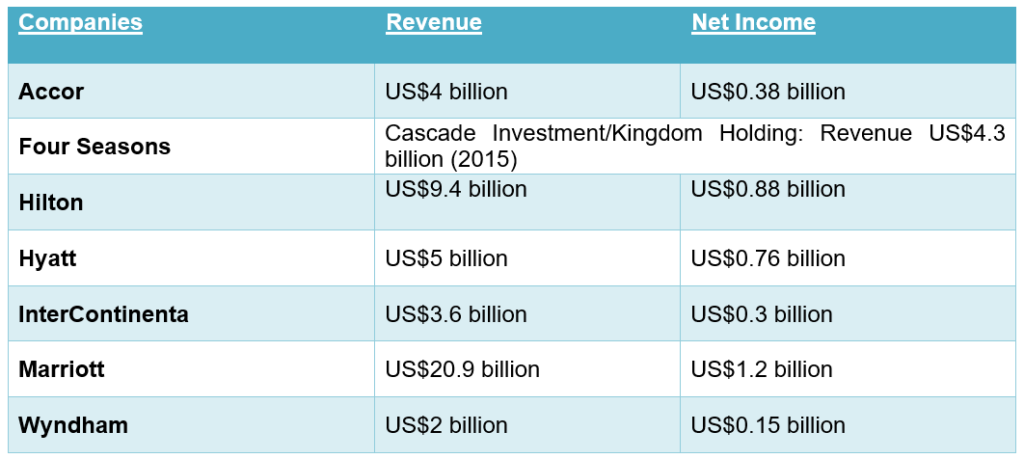
2019 Local Group
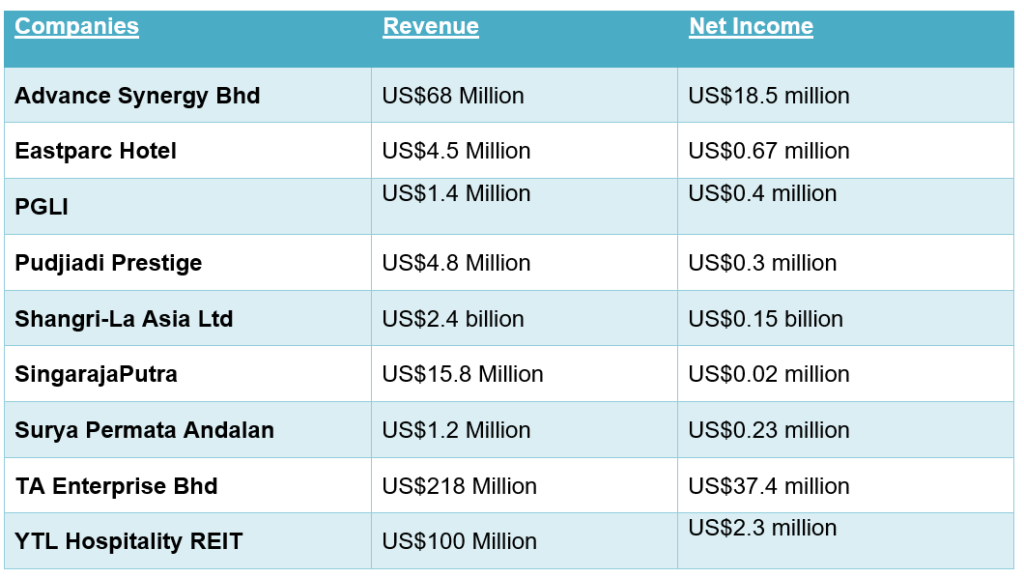
2019 Cruise ship

6.5 Source of Funding:
1. Strategic Investors
- New Investor: A project leadership team bringing expertise in business and financial management.
- Financier: Tourism hotel private equity groups ready to invest in the venture.
- Operator: International and local tourism hotel operator groups with proven track records.
- Target Market: Attracting MNCs from North Asia, China, Central Asia, the Middle East, and India. • Transport: Collaboration with airline and ground transport groups to enhance accessibility.
- Cruise Ship: Partnership with international and local cruise ship groups to broaden tourism options.
- Government: Involvement and support from tourism agencies to align with strategic initiatives.
2. Private Equities and Investors
- Alta Capital Real Estate
- Apollo Global Management
- BlackRock
- Blackstone
- Boron Investments
- Boston Global
- CA Indosuez Gestion
- Canada Pension Plan Investment
- Capital Research & Management
- Cascade Investment
- Causeway Capital Management
- CDPQ
- Cedar Rock Capital
- CIBC Private Wealth Advisors
- Commerz Real
- D. E. Shaw
- Eagle Point Hotel Partners
- Eaton Vance Management
- EII Capital Management
- FIAM
- Fidelity Management & Research
- Fiera Capital
- FIL Investment Management
- Fortress Investment Group
- Franklin Mutual Advisers
- Fundsmith
- Gates Capital Management
- Geode Capital Management
- Goldman Sachs Asset Management
- Harris Associates
- HotCap Asset Management
- Huazhu Group
- Impactive Capital
- IRIS Capital
- Jackson Square Partners
- J.P.Morgan Asset Management
- Kingdom Holding
- KKR
- KLP Enterprises
- Lombard Odier Asset Management
- MFS Investment Management
- Millennium Management
- Melvin Capital Management
- Morgan Stanley
- Norges Bank Investment Management
- PAG
- Parametric Portfolio Associates
- Pershing Square Capital Management
- PRIMECAP Management
- Principal Global Investors
- Pro-invest Group
- Public Investment Fund (Investment Company)
- Qatar Investment Authority (Investment Management)
- RBC Private Counsel
- Schroders Capital
- Seafarer Capital Partners
- Senator Investment Group
- Shanghai State-Owned Assets Supervision & Administration
- Sona Asset Management Cayman
- Southeastern Asset Management
- SSgA Global Advisors
- Starwood Capital Group
- Susquehanna Financial Group
- Templeton Global Advisors
- TIAA-CREF Investment Management
- Triples Holdings
- T. Rowe Price Associates
- Truist Bank (Private Banking)
- Vanguard Group
- Victory Capital Management
- Wellington Management
- William Blair & Company
3. Consultants, development and funding managers to the hotel tourism industries
- American Hotel & Lodging Association
- BCG (Boston Consulting Group)
- EHL Hospitality Business School
- Ernst & Young
- Confederation of Tourism & Hospitality
- Global Business Travel Association
- HOTELS magazine
- Hotels Restaurants & Cafes in Europe (HOTREC)
- HVS
- International Air Transport Association (IATA)
- International Hotel & Restaurant Association (IHRA)
- KPMG
- Les Roches International School of Hotel Management
- McKinsey & Company
- Pacific Asia Travel Association (PATA)
- PwC (PricewaterhouseCoopers)
- Sabah Tourism Board
- Sarawak Tourism Board
- Sarawak Tourism Federation
- UNWTO (United Nations World Tourism Organization)
- United Federations of Travel Agents’ Associations (UFTAA)
- World Travel and Tourism Council (WTTC)
6.6 Where is the hidden gem?
Derawan Archipelago, East Kalimantan, Indonesia:
- Comprising 31 islands.
- Standout Islands: Derawan, Kakaban, Maratua, and Sangalaki.
- Nestled within the Coral Triangle, a marine biodiversity hotspot.
- Represents unexplored frontier tourism destinations with rich natural beauty.
Derawan Island Coral Triangle
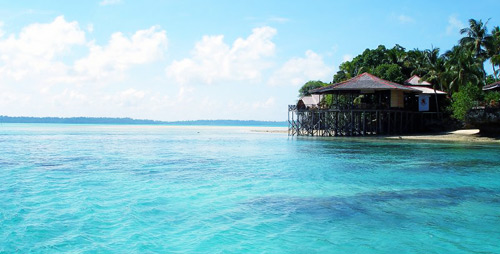
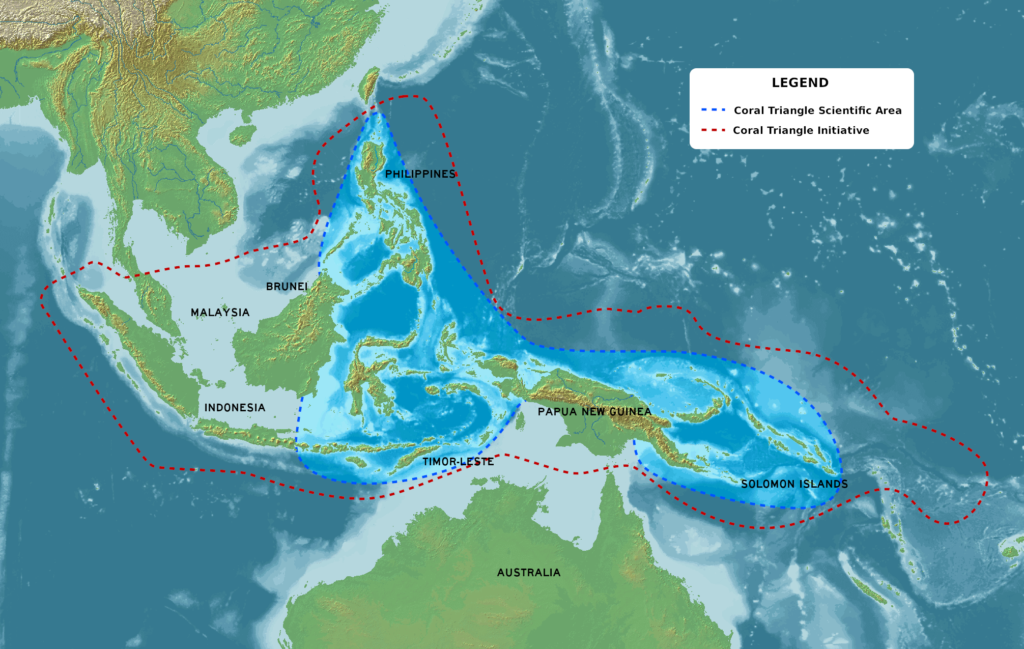
7.0 Management Team
7.1 Key Management Team
- Mentors: Visionary pioneers and industry leaders, offering invaluable guidance and inspiration through a vast global network.
- Coaches: Mission-oriented industry experts providing practical solutions, ensuring a focused pursuit of objectives.
- Partners:
- A project leadership group with a proven track record in developing, operating, and managing financial aspects of the tourism hotel industry.
- A reputable investment manager with access to diverse funding sources in the tourism hotel sector.
- International tourism hotel operators.
- Reputable local tourism hotel operators with procurement capabilities, a robust local network, sound financial status, and government support.
- Target market customer groups.
In the tourism hotel industry, several global leaders have made significant contributions, shaping its growth and success. Here is a list of some of these remarkable individuals, honoured for their vision and dedication:
These are just a few of the outstanding professionals and captains of the industry. The readers are encouraged to explore further and conduct their research to learn more about the management teams in this dynamic field.
7.2 Key Management Team Model
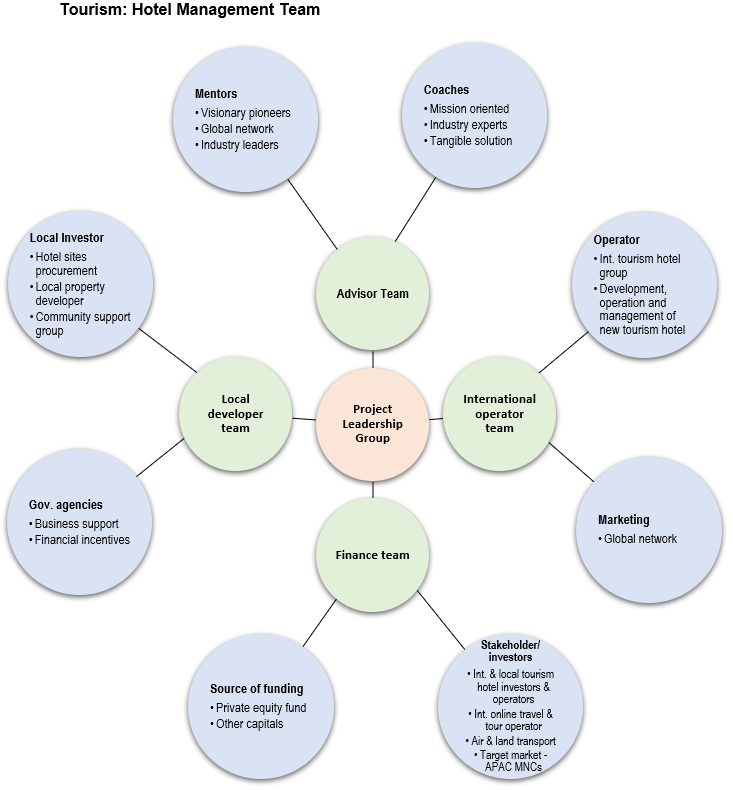
8.0 Unique Business Model
8.1 Successful Track Record
The triumph of a 5-star hotel venture hinges on these pivotal factors:
- Location
- High-Quality Management Team
- Deep Pockets for Long-term Vision
- Profit and Capital Growth
- Securing Anchor Tourists in the Target Segment
8.2 Entry Model
- New: Collaborate with local developers for optimal location selection. A mixed-use development integrating hotels and shopping malls adds project value.
- Operator: Appoint an international 5-star hotel group for enhanced credibility, inspiring confidence among investors and financiers.
- Finance: Seek financing partners to provide bridging and end finance for the project.
- Contract: Opt for a Management Contract, such as a Hotel Management Agreement or Franchise Operators Agreement.
8.3 Unique Business Model
- Team: Assemble a top-notch international management team with a proven track record.
- Scale: Develop 20 5-star hotels under a single entity, offering a plethora of choices for target tourists.
- Service: Adopt a differentiation strategy, delivering high-quality services in a holistic approach tailored for the target tourist.
- Location: Identify and seize prime locations as early movers in the market.
- Brand: Establish a regional chain focusing specifically on Borneo’s 5-star hotel brand image.
- Market: Form strategic alliances with target market segments during the planning stage to secure anchor tourists, ensuring significant income guarantees.
9.0 Key Success Factors & Risk Mitigation
9.1 Key Success Factors
- High-Quality Customer Services
- Prime Locations
- Differentiation
- Target Markets and Regions as Anchor Customer Base
- Scale of Operation
- Strong Financial Backing
- Alignment of Goals with Partners
9.2 Risks
- Health: Health risks due to COVID-19.
- Economic: Current downturn in the tourism industry.
- Revenue: The significant risk is a decrease in revenue.
- Profit: Timing affecting profits at the exit stage.
9.3 Risk Mitigation
- COVID-19 Vaccination Certification
- Capture Recession Opportunity to Build Hotels
- Goal Alignment with Niche and Target Market for Secured Occupancy Rates
- Expect Higher Property Capital Gain After Payback Period
10.0 Exit Strategy
10.1 Forms of Exit
- IPO, Buy-out, M & A, and Transfer.
10.2 Key Attractions for New Investors
- Portfolio: Investment opportunities in emerging market tourism hotel projects.
- Revenue: Long-term revenue-generating projects.
- Demand: Secure demand from the target market.
- Brand: Established 5-star hotel operators.
- Team: Solid management team with a successful track record.